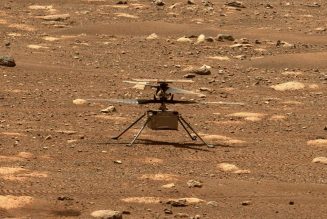Nvidia is officially announcing its RTX 40-series GPUs today. After months of rumors and some recent teasing from Nvidia, the RTX 4090 and RTX 4080 are now both official. The RTX 4090 arrives on October 12th priced at $1,599, with the RTX 4080 priced starting at $899 and available in November. Both are powered by Nvidia’s next-gen Ada Lovelace architecture.
The RTX 4090 is the top-end card for the Lovelace generation. It will ship with a massive 24GB of GDDR6X memory. Nvidia claims it’s 2-4x faster than the RTX 3090 Ti, and it will consume the same amount of power as that previous generation card. Nvidia recommends a power supply of at least 850 watts based on a PC with a Ryzen 5900X processor.
Inside the giant RTX 4090 there are 16,384 CUDA Cores, a base clock of 2.23GHz that boosts up to 2.52GHz, 1,321 Tensor-TFLOPs, 191 RT-TFLOPs, and 83 Shader-TFLOPs.
%2Fcdn.vox-cdn.com%2Fuploads%2Fchorus_asset%2Ffile%2F24038585%2Fimage.png&w=2400&q=75)
Nvidia is actually offering the RTX 4080 in two models, one with 12GB of GDDR6X memory and another with 16GB of GDDR6X memory, and Nvidia claims it’s 2-4x faster than the existing RTX 3080 Ti. The 12GB model will start at $899 and include 7,680 CUDA Cores, 7,680 CUDA Cores, a 2.31GHz base clock that boosts up to 2.61GHz, 639 Tensor-TFLOPs, 92 RT-TFLOPs, and 40 Shader-TFLOPs.
The 16GB model of the RTX 4080 isn’t just a bump to memory, though. Priced starting at $1,199 it’s more powerful with 9,728 CUDA Cores, a base clock of 2.21GHz that boosts up to 2.51GHz, 780 Tensor-TFLOPs, 113 RT-TFLOPs, and 49 Shader-TFLOPs of power. The 12GB RTX 4080 model will require a 700 watt power supply, with the 16GB model needing at least 750 watts. Both RTX 4080 models will launch in November.
It wouldn’t be a new RTX launch without Nvidia’s own Founders Edition graphics cards. Nvidia will sell GeForce RTX 4090 and RTX 4080 (16GB) graphics cards with its own in-house design. It’s a design that the company has upgraded once again.
%2Fcdn.vox-cdn.com%2Fuploads%2Fchorus_asset%2Ffile%2F24038626%2Fgeforce_rtx_4090_product_photo_001.png&w=2400&q=75)
“For our new GeForce RTX 40 Series Founders Edition graphics cards, we’ve further optimized the Dual Axial Flow Through system, increasing fan sizes and fin volume by 10%, and upgrading to a 23-phase power supply,” explains Andrew Burnes, technical marketer at Nvidia. “Memory temperatures are reduced, and the new, substantially more powerful Ada GPUs are kept cool in ventilated cases, giving gamers excellent overclocking headroom.”
Nvidia is supporting the PCIe Gen-5 16-pin connector with its own RTX 40-series cards, instead of the custom solution it created for its own RTX 30-series Founders Edition GPUs. Like the previous connector, it’s a single cable that will power a 40-series card, or you can use an adapter that’s included in the box to connect up three 8-pin power connectors. Nvidia says you might even want to connect up a fourth one for “more overclocking headroom.”
ATX 3.0 power supplies that will natively support PCIe Gen-5 16-pin connectors are arriving in October from Asus, Cooler Master, FSP, Gigabyte, iBuyPower, MSI, and ThermalTake. More models from other manufactures are expected soon, too. Nvidia says Asus, Colorful, Gainward, Galaxy, Gigabyte, INNO3D, MSI, Palit, PNY, and Zotac will all start shipping custom RTX 40-series cards soon too.
Ada Lovelace, named after the English mathematician and writer, is the third generation of RTX that powers both the RTX 4080 and RTX 3090. It’s designed to greatly improve ray tracing and support Deep Learning Super Sampling (DLSS) 3.0. This new architecture will also form the foundations for Nvidia’s next-gen consumer GPUs.
Nvidia introduced its third-generation Ada Lovelace RTX architecture with a Racer X demo today — a simulation of an off-road kart racing game. The Racer X demo was powered by a single Ada Lovelace GPU, which includes 76 billion transistors and is built on TSMC’s 4nm process.
%2Fcdn.vox-cdn.com%2Fuploads%2Fchorus_asset%2Ffile%2F24038530%2F9RxVqpE.png&w=2400&q=75)
Ada Lovelace also includes third-generation RT cores that are designed to greatly improve ray tracing. Part of the improvements come down to a new DLSS 3.0 AI that processes the new frame and the prior frame to figure out how game scenes are changing. Nvidia demonstrated Microsoft Flight Simulator frame rates more than doubling using DLSS 3.0.
The launch of RTX 40-series cards comes at a challenging time for Nvidia and the GPU market as a whole. GPU demand has been dampened by the crypto crash, and more recently, the prevalence of GPU-based crypto mining has plummeted thanks to Ethereum’s switch to proof of stake. Nvidia’s gaming revenue dropped by a staggering $1 billion in its latest earnings.
Nvidia’s launch is focused on its first-party “Founders Edition” graphics cards, but these will be sold alongside additional GPUs from hardware partners such as Asus and Gigabyte. These third-party GPU models use the same Nvidia processors but may be configured differently and have different coolers. But don’t expect to see RTX 40-series GPUs from EVGA, which recently announced it would no longer be making Nvidia graphics cards, citing poor behavior from the chip maker.
Although its successor is now official, previous RTX 30-series GPUs are likely to be available for some time to come. Earlier this year, Nvidia admitted it built too many GPUs and was forced to adjust retail pricing due to excess inventory. This resulted in RTX 30-series cards appearing at MSRP after years of price hikes by resellers, a welcome sight for cash-strapped PC gamers.
Developing…









